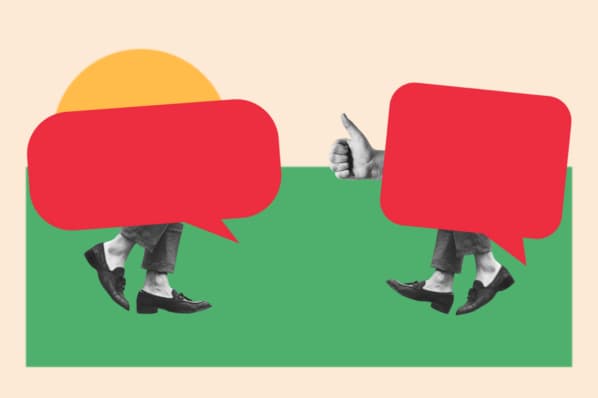Why text sales prospects?
Texting sales prospects may seem like a breach of boundaries and even a faux pas, but how many unread emails versus texts do you have right now?
If you’re like most people, the first number is far bigger than the second. Research shows that 42% of commercial text messages are opened compared to 32% of emails.
Salespeople should take note. It’s difficult to get on buyers’ radars in the first place, let alone stay there. Text and live chat can be fantastic mediums for staying top-of-mind for your prospects, which is leading to the evolution of business conversations.
Is it legal to text sales prospects?
Yes, it is perfectly legal — so long as prospects willingly provided their information to you and opted in for texts. Keep in mind that you should only text sales prospects after you’ve connected with them via another medium such as email or phone.
Otherwise, you risk violating privacy laws and also contacting a customer on a medium they don’t expect to be contacted on. That’s a sure way to scare them off.
Does text messaging for sales violate privacy laws?
No, text messaging does not violate privacy laws if prospects opted in to receive commercial text messages from your business. According to the Telephone Consumer Protection Act guidelines, your request for them to opt in must outline several key pieces of information, such as potential carrier costs and instructions to opt out.
To get customers to sign up, you can ask them to text a keyword to a mobile number. You can also have them check a communications consent box when they send an inquiry to your sales team. Additionally, you may run promotions whose terms include an opt-in for texts.
Don’t forget to send a confirmation text (ie “You’ve been signed up on our mailing list! Text STOP to opt out”). That way, prospects have an opportunity to truly opt-in with consent.
Should you cold text prospects?
No. Never cold text prospects without having a prior conversation with them. Not only is it illegal to reach out without their explicit consent, but it will put off prospects who would’ve been otherwise interested in starting a professional relationship with you.
In the next section, we’ll cover how you can text prospects while still remaining professional and increase the chances of a close.
The following guidelines will help you reap the benefits of text while staying professional.
How to Text Sales Prospects
1. Get prospects to opt in to receiving texts.

First and foremost, get prospects’ consent prior to texting them. You have a few options:
- Incorporate an opt-in checkbox in the inquiry form.
- If you run a promotional campaign, include a disclaimer that providing their phone number gives you permission to text them.
- Ask them to text a keyword to a commercial number to willingly opt-in.
That way, they expect communication from you through that medium. If they use a work cell phone, they may not be as surprised, but that’s impossible to know (unless you’re close to the prospect and know that they use a work phone to communicate with salespeople).
Most commercial SMS strategies are looked through the lens of mobile marketing. When commercial SMS is used in sales, much of the same rules apply. Allow prospects to opt out, only send follow-up texts after a certain period, and remain concise and professional. That will ensure the success of your sales text messaging efforts.
2. Have a discovery call prior to texting the prospect.
Suppose Sarah, an enterprise salesperson, receives a notification that a new prospect just downloaded an ebook. She sends a text to the cell phone number he provided:
“Hey Jimmy! Let me know if I can answer any questions about the latest agronomic trends. — Sarah, Sigment account executive”
If you feel this approach is too forward, you’re not alone. Sending text messages to a prospect before connecting with them on the phone decreases the likelihood you’ll ever connect because it comes across as pushy.
Even if you successfully contact your prospect via text, they’re less likely to eventually buy compared to prospects you didn’t text before calling. Why? Because they have no personal connection with you. They’ve never spoken with you on the phone, heard your value proposition, or even given much thought to your product offerings.
But what if you have a discovery call and then text? You can foster a much more personal connection, articulate your value proposition, and have the opportunity to hear about your prospects’ pain points.

When you reach out over text, it’ll be to reinforce the work you’ve already done — as opposed to trying to form a relationship from the ground up.
With that in mind, don’t text buyers until you’ve talked to them on the phone.
3. Ask for permission verbally.
Aside from getting their consent via an opt-in checkbox or campaign, ask for permission verbally as well to ensure that they know your text message is coming.
This is especially important if you’re worried your prospect will react negatively to an unexpected message.
At the end of Sarah’s first call with Jimmy, for example, she might say, “Would it be okay if I texted you? My customers tell me it’s faster and more convenient to confirm our meetings or get information over text than email.”
This request will be successful for two reasons. First, Sarah establishes this is a normal practice — she commonly texts other customers. Second, she indicates why texting is in Jimmy’s benefit. He’ll immediately picture how much easier it’ll be to open a text than yet another email.
You should also factor in your prospect’s industry, buyer persona, and individual personality. Maybe Jimmy works in an extremely conservative, highly regulated industry. His organization probably does everything by the book, which suggests he’d prefer to communicate over email.
On the other hand, if Jimmy is in an emerging space or belongs to an experimental company, he’ll likely be far more enthusiastic about the idea of texting or chatting.
4. Choose the right texting cadence.
Spam is spam, whether it’s sent via email, LinkedIn message, or text. Be cautious about how often you text your prospects and what you say — if you abuse your texting privileges, they’ll quickly stop trusting you and may even ask you to leave them alone.
Every text message should have a clear purpose. Acceptable ones include:
- Checking your prospect's availability for a call or meeting
- Confirming a call or meeting
- Sending a helpful resource
- Briefly answering a question they’d asked earlier

Unacceptable reasons include:
- Just “checking in”
- Asking why they didn’t answer your email
- Reiterating your product’s features or benefits without adding value
5. Keep it short.
Brevity is always important when communicating with prospects, but it’s especially crucial when you’re texting. Long texts will fill up the buyer’s entire screen and can easily look overwhelming.
Try to write as little as possible. If your message is more than 300 characters — and you can’t delete anything — consider sending an email instead.
6. Strike the right balance between professionalism and friendliness.
Maintaining professionalism is also key. Even though you’re texting, emojis, acronyms, and sloppy punctuation and capitalization are still inappropriate. Don’t make your prospect feel like they’re back in middle school.
That being said, you can still add some personality. Friendliness goes a long way in humanizing you and the interaction.

To illustrate the right balance of personality and professionalism, here are three examples.
Too casual: “ayo, Jimmy! thanks for getting on that call today. i have the answer to ur question about monthly volume. its probably something we should cover on the phone. :P Are u free tomorrow at 1 p.m.?”
Too stiff: “Hello, Jimmy. Thank you for speaking with me today. I have the information you requested regarding monthly volume. The complexity necessitates a phone call. Are you available tomorrow at 1 p.m.?”
Just right: “Hi, Jimmy. I did some digging and found the answer to your question about monthly volume. It’s not straightforward, so we should cover it on another call. Are you free tomorrow at 1 p.m.?”
7. Only text during business hours.
Lastly, don’t send texts outside of business hours. Because texting is such a personal medium, it can feel invasive to receive a professional message at, say, 9 p.m. And don’t forget your prospect’s time zone — if they’re several hours ahead or behind you, you might unintentionally message them when they’re trying to sleep. Few people appreciate getting texts in the night.
Don’t know what a sales text message can look like? Below are a few examples.
Sales Text Message Examples
1. Sales Text Message for Objection Handling
 Hi [first name], I spoke to our VP about your questions surrounding pricing, and it seems we can [insert compromise]. I would love to discuss over the phone. Is Friday at 3 PM a good time?
Hi [first name], I spoke to our VP about your questions surrounding pricing, and it seems we can [insert compromise]. I would love to discuss over the phone. Is Friday at 3 PM a good time?
-[Your name]
Why It Works
During your discovery call, your prospect likely brought up an objection that has the potential to bring the deal to a halt. Use a text message to let them know you’ve found a solution to the issue and schedule a follow-up meeting to discuss.
2. Sales Text Message Before an Event
 Hi, [first name]. This is [first name] from [company]. Tomorrow is finally the first day of [event name]! I would love to see you at our booth and show you a live sample of the product. At what time will you be coming, and which product are you most interested in seeing?
Hi, [first name]. This is [first name] from [company]. Tomorrow is finally the first day of [event name]! I would love to see you at our booth and show you a live sample of the product. At what time will you be coming, and which product are you most interested in seeing?
Why It Works
This sales text message works if you’ve been speaking with the prospect for a few weeks and were apprised that they’ll be at an event you’ll also be in. It gives you an opportunity to meet them in person and deliver a pitch in an environment where pitches are expected. We don’t recommend using this text if you’ve just connected with the prospect.
3. Sales Text Message After an Event
 Hi, [first name]! It was great seeing you at [event name] today. Since you were curious about [feature], I wanted to send over this leaflet: [link]. I’d love to discuss in more detail over a call. Are you available next Tuesday at 3PM?
Hi, [first name]! It was great seeing you at [event name] today. Since you were curious about [feature], I wanted to send over this leaflet: [link]. I’d love to discuss in more detail over a call. Are you available next Tuesday at 3PM?
Why It Works
This text shows critical listening skills — you noticed what your prospect was most curious about and sent them more information. But as with any sales email, it also includes a call-to-action to prompt them to continue engaging with you. You can add or omit details as you’d like to make this text message work for you.
4. Sales Text Message After Trial
 Hi [first name], this is [your name] from [company]. Did you enjoy your 7-day trial of [product]? I’d love to chat over a potential trial extension. Would Wednesday at 9 AM work for you?
Hi [first name], this is [your name] from [company]. Did you enjoy your 7-day trial of [product]? I’d love to chat over a potential trial extension. Would Wednesday at 9 AM work for you?
Why It Works
When used appropriately, this text message can help you get a follow-up call booked with much more ease than a normal email. Because most B2B software users don’t expect to interact over text, be sure to know your audience, and to ask for permission first.
Text Messaging for Better Sales Conversion
With the right strategy, texting can help you close your deals much more effectively than with sales calls and email alone. Follow these guidelines to ensure your texts are professional, helpful, and relevant, and watch your conversion rates rocket.
Editor's note: This post was originally published in January 2017 and has been updated for comprehensiveness.
Sales Communication
.png?width=112&height=112&name=Sales%20Conversion%20and%20Close%20Rate%20Calculator%2001-300%20(1).png)



![Active Listening Techniques To Use On Your Next Sales Call [+ Examples]](https://53.fs1.hubspotusercontent-na1.net/hubfs/53/active-listening-1-20250218-4164086.webp)
![How to Reply to a Sales Rejection Email From a Client [+ Templates]](https://53.fs1.hubspotusercontent-na1.net/hubfs/53/timing-objection-responses-1.jpg)




%20(1).png)

